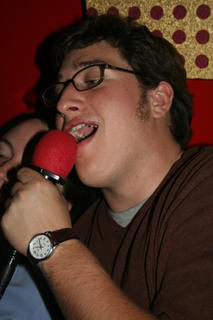Shanxi
It has been a while since I have posted. Things have been going pretty swimingly. I am now an official resident of the city of Beijing. I am about four days away from my first major exam. Things are going pretty well. In this sort of situation I find it hard to post. It is something I have to work on. Life here at Qinghua is quite nice. The fall weather has been cold, but it also tends to be clear, I can even see the mountains from my class room on most days.

I got back last night from this semesters "free" Field trip to Shanxi province. (If you want to find Shanxi on a map it is south of Inner Mongolia, west of Hebei province and Beijing.) It was a blitz two day trip to see the provinces chief historical and cultural sites. I have included some pictures for all of you.
Nowadays Shanxi is known for coal and carbohydrates. The city of Datong in Shanxi, where we spent the first night, is the site of the country's largest coal mine. The local food of Shanxi is mostly wheat and rice noodles. I have to say, it was really pleasant to get away from my spicy Beijing food for a couple of days of hearty peasant food. I think a highlight was the millet porridge on our last morning. As all of our travel was by bus we got a chance to see a lot of the countryside. It reminded me quite a bit at different times of Idaho, Montana and Nebraska. At times stark terraced mountains would give way to high dessert, while at others rolling hills would be dotted with cows and sheep. Beef it seems is also very common in Shanxi. In beijing, while you can easily eat beef, pork and Yang(sheep or goat, they use the same character) are much more common.

 The night life in Datong is somewhat lacking. However on our fist night I went to a Karaoke bar with my norwegen roomate Christian, fellow Reed Alum Jenn Smith, and my isreali classmate Yoel. Karaoke is the tool of the devil. It encourages public humiliation and drunkeness. It was fun.
The night life in Datong is somewhat lacking. However on our fist night I went to a Karaoke bar with my norwegen roomate Christian, fellow Reed Alum Jenn Smith, and my isreali classmate Yoel. Karaoke is the tool of the devil. It encourages public humiliation and drunkeness. It was fun.  In the morning we (the fifty or so of us on the fieldtrip) made our way to the Yungang grotto. The Yungang grotto is a cliff face with fifty carvings, most of them quite large, of the three aspects of the the Buddha, usually accompanied by a host of minor deities, attendants, etc. Some of the grottos are cavernous rooms with hundreds of carvings around a central buddha several stories tall, while others are small rooms with a single statue. The carvings all date back to the fifth century AD. It was cold an windy, but rather beautiful.
In the morning we (the fifty or so of us on the fieldtrip) made our way to the Yungang grotto. The Yungang grotto is a cliff face with fifty carvings, most of them quite large, of the three aspects of the the Buddha, usually accompanied by a host of minor deities, attendants, etc. Some of the grottos are cavernous rooms with hundreds of carvings around a central buddha several stories tall, while others are small rooms with a single statue. The carvings all date back to the fifth century AD. It was cold an windy, but rather beautiful. 
After the grotto we drove to the Xuankongsi hanging temple. The hanging temple is precariously perched on the side of a cliff. The rooms inside it are generally less than four feet deep. It is hard to tell from this picture but the cliff is flat behind the temple. They did not carve out the cliff to accommodate it. Basically climbing up into the temple is not for the faint of heart, but it was well worth it. Also interesting, this temple contains Buddhist, daoist, and Confucian alters. It is a good reminder of how these three very different traditions coexisted for so long. (Hmm... pictures do not seem to want to load, oh well.)
The last stop of the day was the Yingxian Muta. What really makes this pagoda remarkable is its age. The pagoda has been standing for 900 years, and is made completely of wood. There is not a single nail. It seems the cold dry climate of Shanxi is good for wood.
The last place we stopped was the ancient city of Ping Yao. The city would be Disneyland if people did not actually live there. In the 17th, 18th and 19th centuries this city was the financial center of the empire, with several different large banks making commercial loans. By some fluke of history no one bothered to tear down the old city to make way for the future. Perhaps it seemed out of the way compared to Datong in the coal rich north. In any event the whole city is still cobblestones and Ming style courtyard houses. The city even has a (slightly reconstructed) city wall, something that did not survive growth and development in other cities. Our hotel here was fantastic, we slept on traditional Kangs (flat sleeping surfaces heated from below) and our rooms opened out into a large common courtyard.
(I will try to add the rest of the pictures later.)


0 Comments:
Post a Comment
<< Home